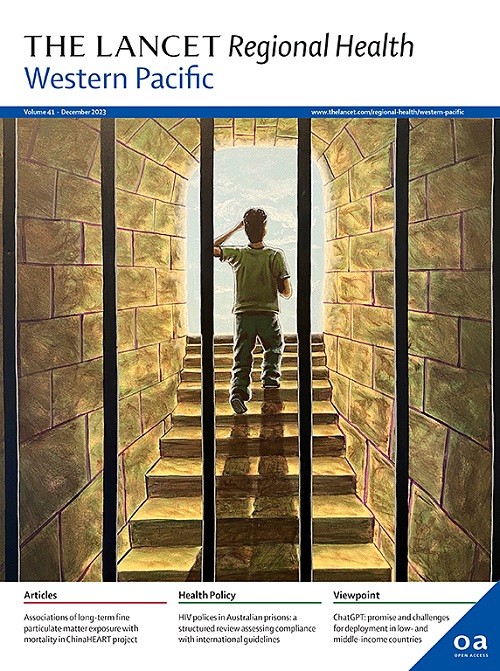磁控胶囊胃镜和血清学筛查胃癌癌前高危事件的横断面研究(SIGES)
IF 7.6
1区 医学
Q1 HEALTH CARE SCIENCES & SERVICES
引用次数: 0
摘要
背景胃癌是中国常见的恶性肿瘤,对其癌前高危事件进行筛查和早期发现有助于监测高危亚人群,提高人群生存率。磁控胶囊胃镜(mcg)作为一种新型的、无创的、更好的依从性诊断方法,用于筛查胃癌和癌前高危疾病,如萎缩性胃炎、胃溃疡和胃息肉。在筛查胃癌癌前高危事件方面,MCCG的有效性及序贯血清学-MCCG方案的可行性有待初步评估。方法收集2018 - 2020年在四川大学华西医院健康管理中心进行健康检查的18-75岁人群。人口统计数据包括性别、年龄、种族、教育水平、体重指数、吸烟、饮酒和癌症家族史。这些观察结果进行了mcg和相关血清学检查,包括胃蛋白酶原-1 (PG-I)、胃蛋白酶原-II (PG-II)、胃蛋白酶原- i /-II比值(PGR)、胃泌素-17 (G-17)、癌胚抗原(CEA)和碳水化合物抗原19-9 (CA19-9)。MCCG的主要发现涉及肿瘤和高危癌前事件,如慢性萎缩性胃炎(CAG)、胃溃疡和胃息肉。主要结局指标为所有高危事件,而第二结局指标为上述任何事件。估计MCCG的检出率,并分析血清学对MCCG结果的预测增强。结果共纳入1432名符合条件的健康体检者。MCCG报告无肿瘤,114例有癌前高危事件。所有高危事件的总检出率为79.6‰(95% CI 66.7‰~ 94.8‰),CAG的特异检出率为15.4‰(95% CI 10.1‰~ 23.2‰),胃溃疡的特异检出率为14.7‰(95% CI 9.6‰~ 22.4‰),胃息肉的特异检出率为55.2‰(44.5‰~ 68.3‰)。在mccg阳性(所有高危事件)组和mccg阴性组之间进行比较,基线一般具有可比性,只有年龄例外。老年人的高危事件发生率明显更高(P<0.001),尤其是≥60岁的老年人。所有血清学检查水平在mccg阳性组和mccg阴性组之间无显著差异。然而,对于CAG结局数据集,CAG组PG-I(中位数58.9 ug/L, IQR为44.3 ug/L-85.2 ug/L, P=0.016)和PGR(中位数6.2,IQR为3.4-9.5,P=0.017)水平显著降低,G-17 (P=0.009)。血清学不能很好地预测所有高危事件数据集,但血清学CAG对MCCG CAG具有很强的预测能力(校正诊断优势比[aDOR]=10.40, 95% CI 2.08-51.98;SPE = 98.6%;LR + = 8.85)。此外,CA19-9血清阳性预测MCCG胃溃疡(aDOR=7.86, 95% CI 1.58-39.08;Spe = 97.8%;LR + = 4.72)。血清G-17和CEA阳性不能预测任何高危事件。mcg在胃癌癌前高危事件的检测中可能具有一定的能力。MCCG是筛查胃癌高危候选者的一种选择,从个人依从性的角度考虑,尤其对老年人而言。血清学CAG和CA19-9血清阳性可视为mcg的预先适应症。更好的序列血清学- mccg方案需要在成本效益方面进一步研究和优化。本文章由计算机程序翻译,如有差异,请以英文原文为准。
Magnetically controlled capsule gastroscopy and serology for screening precancerous high-risk events of gastric cancer: a cross-sectional study (SIGES)
Background
Gastric cancer is a common malignancy in China, while screening and early detection of its precancerous high-risk events might help surveillance of high-risk subpopulation and improve the population survival. Magnetically controlled capsule gastroscopy (MCCG) emerged as a novel, non-invasive, and better compliant diagnostic method for screening gastric cancer and precancerous high-risk conditions, such as atrophic gastritis, gastric ulcer, and gastric polyp. The effectiveness of MCCG and the feasibility of sequential serology-MCCG protocol need to be preliminarily assessed in the aspect of screening precancerous high-risk events of gastric cancer.
Methods
This cross-sectional study collected health check-up observations (18-75 years old) at the Health Management Center, West China Hospital of Sichuan University between 2018 and 2020. Demographic data were retrieved including sex, age, ethnicity, education level, body mass index, smoking, alcohol drinking, and family history of cancers. Those observations had undergone MCCG and relevant serologic examinations including pepsinogen-I (PG-I), pepsinogen-II (PG-II), PG-I/-II ratio (PGR), gastrin-17 (G-17), carcinoembryonic antigen (CEA), and carbohydrate antigen 19-9 (CA19-9). Major findings from MCCG concerned tumor and high-risk precancerous events, i.e. chronic atrophic gastritis (CAG), gastric ulcer, and gastric polyp. The primary outcome measure was all high-risk events, while the second outcome measures were any of the above events. The detection rate of MCCG was estimated, and the predictive strengthen of serology on MCCG findings was analyzed.
Findings
A total of 1,432 eligible healthy check-up persons were included. MCCG reported none tumor and 114 cases with any precancerous high-risk event. The overall detection rate was 79.6‰ (95% CI 66.7‰-94.8‰) for all high-risk events, while the specific detection rates were 15.4‰ (95% CI 10.1‰-23.2‰) for CAG, 14.7‰ (95% CI 9.6‰-22.4‰) for gastric ulcers, and 55.2‰ (44.5‰-68.3‰) for gastric polyp, respectively. Compared between MCCG-positive (all high-risk events) and MCCG-negative groups, the baselines were generally comparable, with the only exception of age. The elder persons appeared significantly higher rates of high-risk events (P<0.001), particularly increased as ≥60 years old. All the levels of serologic examinations were not significantly different between MCCG-positive and MCCG-negative groups. However, regarding CAG outcome dataset, the levels PG-I (median 58.9 ug/L, IQR 44.3 ug/L-85.2 ug/L, P=0.016) and PGR (median 6.2, IQR 3.4-9.5, P=0.017) were significantly lower in the CAG group, as well as G-17 (P=0.009). The serology couldn’t well predict in all high-risk events dataset, but serologic CAG performed great predictive strength for MCCG CAG (adjusted diagnostic odds ratio [aDOR]=10.40, 95% CI 2.08-51.98; SPE=98.6%; LR+=8.85). Additionally, CA19-9 seropositivity predicted MCCG gastric ulcer (aDOR=7.86, 95% CI 1.58-39.08; SPE = 97.8%; LR+=4.72). Seropositivity of G-17 and CEA couldn’t predict any high-risk events.
Interpretation
MCCG might perform reasonable capacity of detecting precancerous high-risk events of gastric cancer. MCCG is an alternative for screening high-risk candidates of gastric cancer for the sake of personal compliance, especially for the elders. Serologic CAG and CA19-9 seropositivity could be considered as preposed indications for MCCG. Better sequential serology-MCCG protocol needs further investigation and optimization in the cost-effective aspect.
求助全文
通过发布文献求助,成功后即可免费获取论文全文。
去求助
来源期刊

The Lancet Regional Health: Western Pacific
Medicine-Pediatrics, Perinatology and Child Health
CiteScore
8.80
自引率
2.80%
发文量
305
审稿时长
11 weeks
期刊介绍:
The Lancet Regional Health – Western Pacific, a gold open access journal, is an integral part of The Lancet's global initiative advocating for healthcare quality and access worldwide. It aims to advance clinical practice and health policy in the Western Pacific region, contributing to enhanced health outcomes. The journal publishes high-quality original research shedding light on clinical practice and health policy in the region. It also includes reviews, commentaries, and opinion pieces covering diverse regional health topics, such as infectious diseases, non-communicable diseases, child and adolescent health, maternal and reproductive health, aging health, mental health, the health workforce and systems, and health policy.
 求助内容:
求助内容: 应助结果提醒方式:
应助结果提醒方式:


